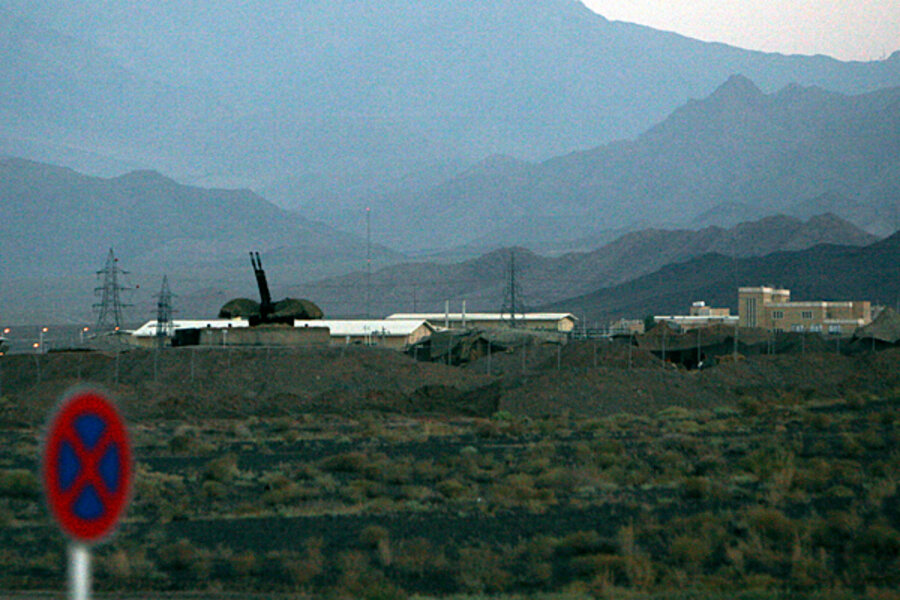Why Iran's nuclear enrichment upgrade may be a 'game changer'
Loading...
| Washington
Iran may be about to install a new generation of uranium enrichment equipment at its big nuclear plant near the central city of Natanz. According to news wire reports, Iran on Jan. 23 notified the International Atomic Energy Agency (IAEA), the United Nations nuclear watchdog, that it plans to introduce more than 3,000 upgraded centrifuges at the Natanz facility, which currently relies upon older IR-1 centrifuge models.
Iran insists its nuclear program is peaceful. The United States and its allies fear Iran is actually developing weapons under the guise of building up civilian reactor technology.
In this context, is the centrifuge news a big deal? Yes, it may be – if Iran is actually able to install the finicky machines and get them to work.
“Iran’s installation of more efficient centrifuges at Natanz could be a game changer,” tweeted Mark Fitzpatrick, director of the nonproliferation and disarmament program at the Institute for Science and International Security, on Thursday.
Centrifuges are the workhorses of fissile material creation. Thin metal tubes that spin at fantastically high speeds, they physically separate different isotopes of uranium gas. This allows operators to slowly create gas that contains more and more U-235, the isotope capable of sustaining a fissile chain reaction.
If that sounds difficult and tedious, it is. Centrifuges work in chains of thousands to produce uranium enriched enough for use in reactors. The more-refined material needed for nuclear weapons take even more time to produce.
Right now Iran uses IR-1 centrifuges based on parts and designs provided by the Pakistani scientist – and notorious nuclear proliferator – Abdul Qadeer Khan. The IR-1 technology is from the 1970s, and Iran has had difficulty in getting the centrifuges to run properly, perhaps in part due to the sabotaging effects of the Stuxnet computer worm thought to have been introduced into the plant by the US and Israel.
Iran has long said it is working on a second-generation IR-2, thought to be based on a later European design that uses superstrong steel instead of aluminum for rotors and is capable of enriching uranium much faster than the IR-1. Now, in a letter to the IAEA, Iran says it will install IR-2m centrifuges in a Natanz “unit”– a technical term that can mean up to 3,132 of the machines, according to the Associated Press.
The Iranians provided no time frame for the work, which would take months, if not a year, to complete. But the move is a blow to the US and its allies at a time when they are trying to get Iran to scale back its nuclear activities and cooperate more fully with IAEA.
The problem as far as the US is concerned is that better centrifuges could shorten Iran’s breakout time to a nuclear weapon.
Right now the 10,000 or so IR1s installed at Natanz are enriching uranium to the level of about 5 percent U-235, which is the level needed for use in a civilian reactor. (At Iran’s Fordow underground facility, a smaller number of centrifuges is enriching uranium to 20 percent, a level needed for some specialized civilian uses.)
At some point, if Iran decides it wants uranium enriched to the 90 percent grade used in weapons, it could simply make a dash for it, taking its stockpiles of 5 percent and 20 percent uranium and refining upwards as quickly as possible.
US intelligence considers this one of the most likely ways Iran would try to get a bomb. Tehran would be wagering that it could get the material developed before the West noticed what was going on and retaliated – or that the US and its allies would not have the political will to retaliate at all, despite Israel’s threats and President Obama’s statements that Iran won’t get the bomb on his watch.
Right now, Iran would require two to four months to produce one weapon’s worth of highly enriched uranium, according to an Institute for Science and International Security (ISIS) report on the subject last fall.
But IR-2 centrifuges work three to four times faster than Iran’s current models, estimates the ISIS. That could shave weeks off its breakout time.
“With advanced centrifuges, Iran could increase by several-fold its production of [uranium enriched to 20 percent] and it could break out with far fewer (less than 1,000) machines. For this reason, any development of advanced centrifuges will inevitably increase tensions,” concludes the ISIS study.






